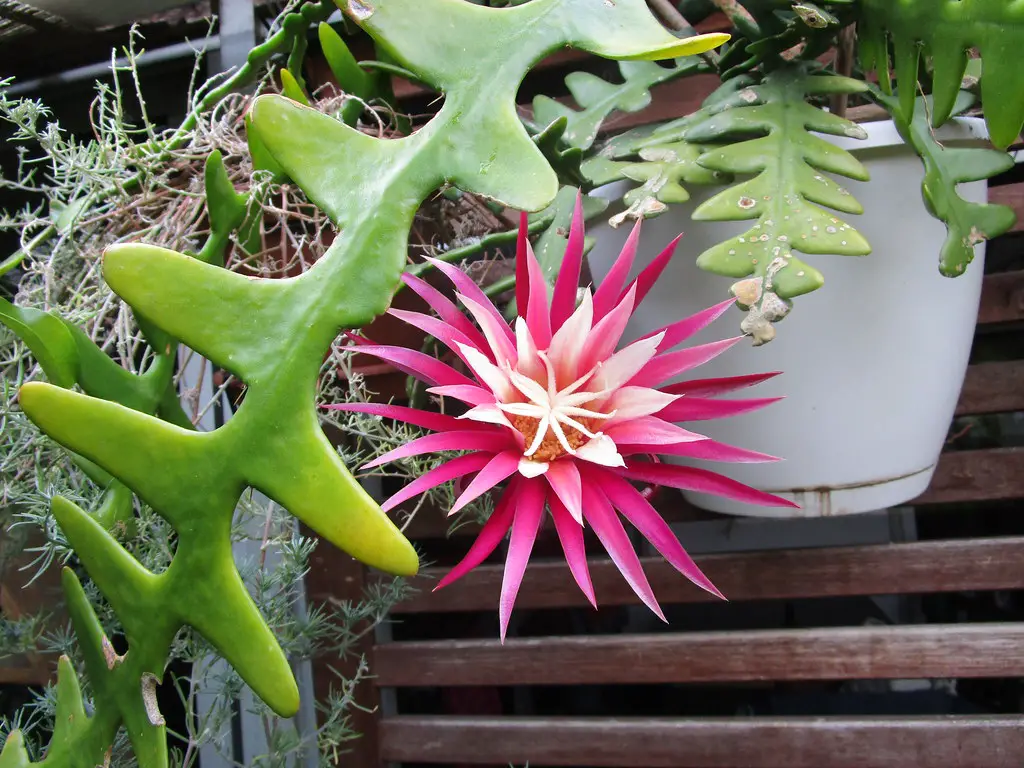The Fishbone Cactus, also known as Epiphyllum anguliger, is an exotic and captivating houseplant that gets its name from its unique fishbone-shaped leaves. Originating from the forests of Mexico, this cactus is more accustomed to life under the canopy, leading to care requirements that differ from most desert-dwelling cacti. With slender, wavy stems that zig-zag alternately, the Fishbone Cactus adds a touch of whimsy to any interior setting.
Unlike many cacti that bloom only once in their lifetime, the Fishbone Cactus may bloom multiple times, emitting a sweet lemony fragrance. The flowers, usually creamy white with long, slender petals, open at night and can grow up to 8 inches across. In addition to the spectacular blooms, it’s also admired for its ease of care and fast growth, making it a favorite among both beginner and seasoned plant enthusiasts.
What further adds to the Fishbone Cactus’s appeal is its adaptability to various indoor environments. It can thrive in different lighting conditions and humidity levels, allowing it to be a versatile choice for different rooms or offices. Its unique appearance and beautiful nocturnal flowers make it an eye-catching centerpiece.
| Attribute | Details |
|---|---|
| Common Names | Fishbone Cactus, Zig Zag Cactus, Ric Rac Orchid Cactus |
| Botanical Name | Epiphyllum anguliger |
| Family | Cactaceae |
| Plant Type | Epiphytic Cactus |
| Mature Size | 12-18 inches in length |
| Sun Exposure | Partial shade |
| Soil Type | Well-draining, organic-rich soil |
| Hardiness Zones | 10-11 |
| Native Area | Mexico |
Fishbone Cactus Care
Fishbone Cactus is appreciated for its low-maintenance needs, although some attention to watering and lighting will help it flourish. Unlike desert cacti, it prefers a more humid environment and more frequent watering, reflecting its native habitat under the Mexican forest canopy.
Regular fertilizing during the growing season and a well-drained soil mix can provide the nutrients needed for healthy growth. It’s also worth noting that the Fishbone Cactus appreciates some support to keep its sprawling stems in check, making it suitable for pots with stakes or hanging baskets.
Light Requirement for Fishbone Cactus
The Fishbone Cactus thrives in bright but indirect sunlight. Exposure to harsh, direct sunlight can cause the stems to become discolored. An east or north-facing window is usually ideal, providing the gentle light it needs without the risk of scorching.
Soil Requirements for Fishbone Cactus
A well-draining, organic-rich soil mix is essential for Fishbone Cactus. Adding some organic matter like peat or compost along with sand or perlite can create an optimal soil environment. The presence of organic material helps mimic its natural habitat, while good drainage prevents root rot.
Water Requirements for Fishbone Cactus
Unlike typical desert cacti, the Fishbone Cactus requires more frequent watering. Watering should be done when the top inch of soil feels dry, with reduced watering in winter. Overwatering or allowing the soil to remain soggy can lead to root rot, so careful attention to watering is key.
Temperature and Humidity
Fishbone Cactus prefers a temperature range between 60-80°F (15-27°C) and appreciates higher humidity levels. It can be sensitive to drafts and sudden temperature fluctuations, so placing it away from vents or exterior doors is wise. Misting or a humidifier can help maintain adequate humidity levels.
Fertilizer
A balanced, water-soluble fertilizer applied during the growing season will support the Fishbone Cactus’s growth. Over-fertilizing should be avoided, as it can lead to weak, elongated stems.
Pruning Fishbone Cactus
Pruning is rarely necessary for Fishbone Cactus but can be done to control size or remove dead or damaged stems. Using sharp, clean scissors, cuts should be made at the joint where the stem connects to the plant.
Propagating Fishbone Cactus
Fishbone Cactus can be propagated easily through stem cuttings. Cut a healthy stem segment, allow it to air dry for a day or two, and then plant in a well-draining soil mix.
How To Grow Fishbone Cactus From Seed
Growing Fishbone Cactus from seed can be a rewarding yet slow process. The seeds should be sown in a well-draining soil mix and kept moist but not waterlogged. Patience is required, as germination may take several weeks.
Common Pests & Plant Diseases
Mealybugs
Mealybugs can be a nuisance but are usually managed with insecticidal soap or neem oil.
Scale
Scale insects may also attack the plant, and manual removal or insecticides can control the infestation.
Common Problems With Fishbone Cactus
Yellowing Stems
Yellowing stems can be a sign of overwatering. Reducing water and ensuring proper drainage can alleviate this problem.
Weak Growth
Weak, elongated growth may be due to inadequate light or over-fertilization. Adjusting these factors can promote more vigorous growth.
Pro Tips
- Allow the soil to dry slightly between watering to avoid root rot.
- Provide support or a hanging basket to manage sprawling stems.
- Avoid direct sunlight which can cause discoloration.
- Prune only as needed, and propagate through stem cuttings for new plants.
- Consider placing Fishbone Cactus in a room where you can enjoy its fragrant, nocturnal blooms.




